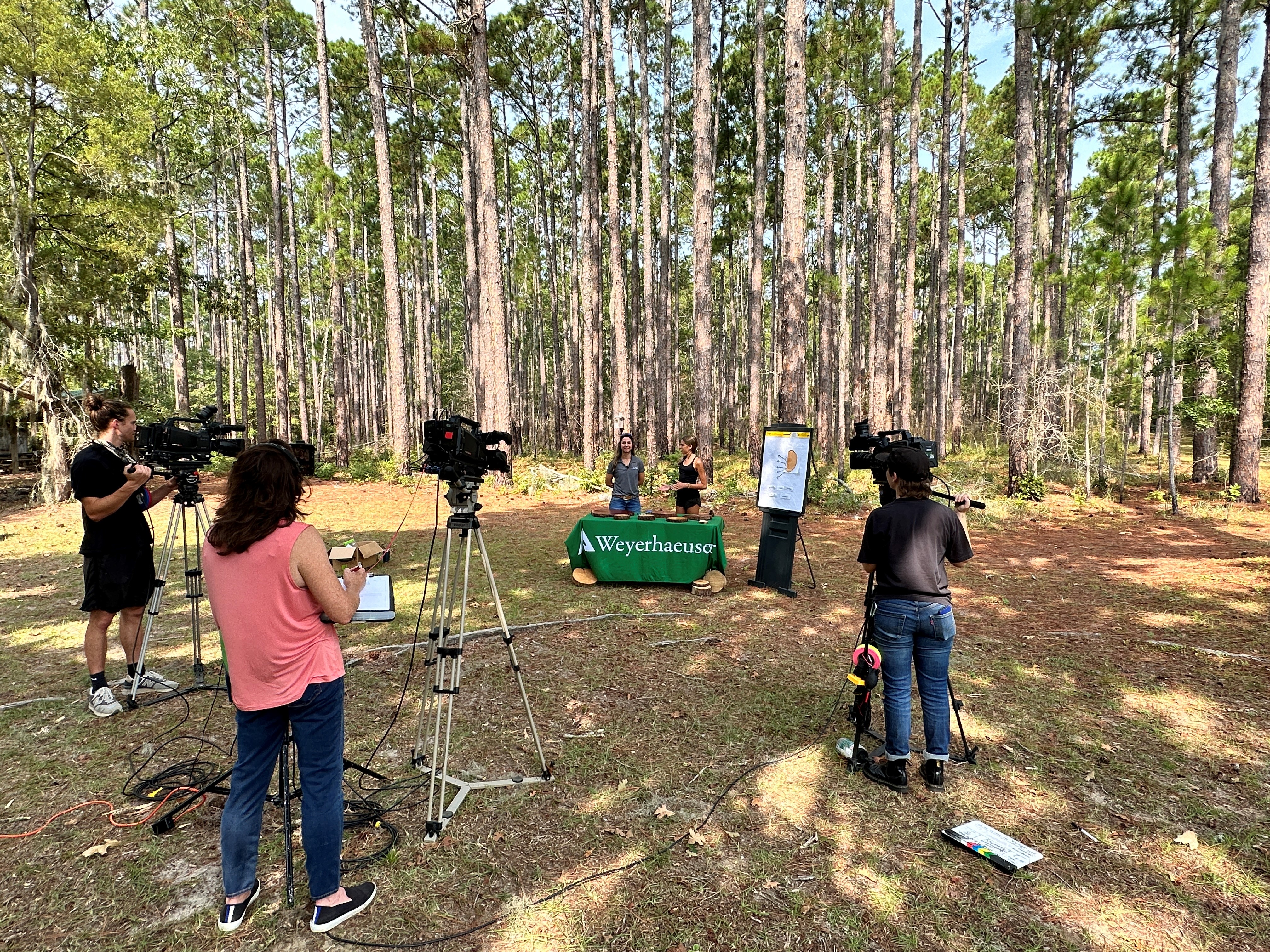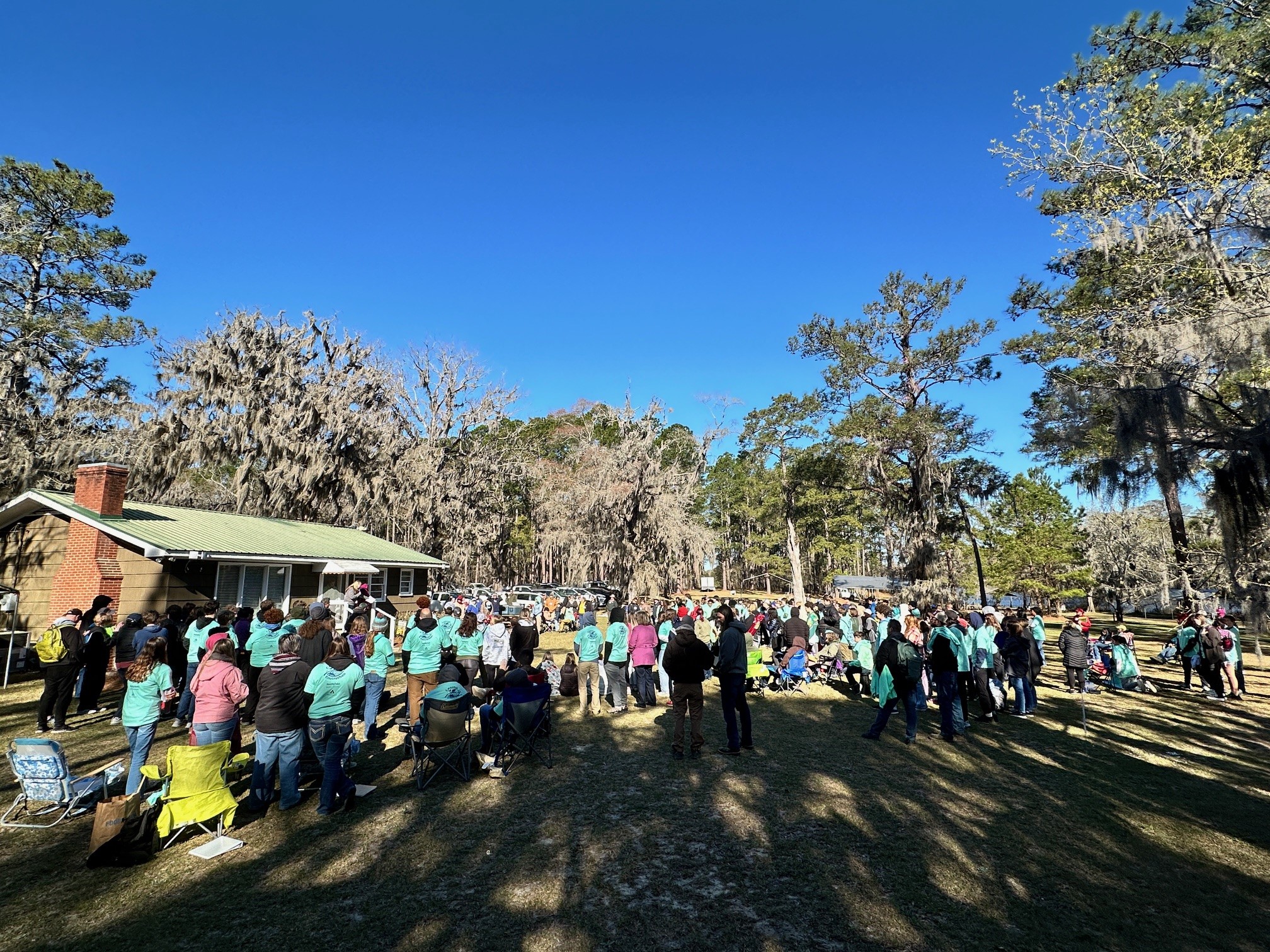
The STEM explorers film crew included three cameras to record the conversation between Blair, behind table at left, and Riley, the show’s young host.
Do you remember what sparked your interest in the timber industry? For many of us, fascination with the outdoors took root when we were kids.
That youthful curiosity is what Blair Owen and Seth Plank, planning and roads foresters based in our Vanceboro, North Carolina, Timberlands office, hoped to tap into when they stepped in front of cameras this summer.
Blair and Seth were featured in a segment of “STEM Explorers,” a TV series aimed at middle school-aged children that airs on public television in North Carolina and several other southern states.
THE PERFECT SET-UP
Getting in front of the cameras came in a roundabout way for Blair and Seth. Show producers originally contacted our Charlotte distribution center in Concord, North Carolina, to see if Weyerhaeuser would be interested in participating. Brad Miller, Distribution’s eastern division inventory manager, forwarded the inquiry to Katie Cava, sustainability program manager at our Seattle Headquarters, who then worked with Andrew Brown, EMS manager in Virginia, and Jocelyn Wilson, Carolinas/Virginia region manager, to identify internal talent.
“Seth and Blair were perfect for the roles,” Katie says. “They were enthusiastic and quick to let me know, ‘We’ve got this.’”
Katie collaborated with them to make sure they covered our key sustainability messages, but she let the two foresters decide how best to make our company’s messaging resonate with young people.
“We want everyone to know we manage our forests on a renewable cycle and harvest a very small percentage — only about 2 percent — of our land each year,” Katie says. “This means the rest of our forests are still growing. And while managing those growing forests, we always think about how to provide habitats for all the plants and animals that live there and the humans who recreate there. Our forests are working forests, and we manage them for timber production, but we never lose sight of the bigger picture.”
The “STEM Explorers” segment was filmed at our Cool Springs Environmental Center near New Bern, North Carolina, which is already set up for education.
“Cool Springs was the perfect location, but we were a bit surprised when the show’s producers told us we had to do some type of experiment,” Seth says. “Luckily, they clarified we didn’t have to do something that explodes — just some type of hands-on activity that would help young viewers understand our sustainability concepts.”
Blair and Riley prep to start filming.
FILMING FUN
Environmental education isn’t an everyday part of their job, but Seth and Blair have both volunteered with the Coastal Envirothon and have connections to educational training.
“Our goal was to come up with something interesting and educational,” Blair says. “Fortunately, Seth and I are both involved in the Society of American Foresters. We had Project Learning Tree training through SAF, which was helpful.”
The Cool Springs website also has a list of forest activities available for the many school groups that make it a field trip destination. These resources and trainings gave Blair and Seth additional ideas on how to tailor big sustainability concepts to younger audiences.
They had just two weeks to prepare their scripts. Each had a standalone segment, about 13 minutes long, with hands-on demonstrations.
Blair presented an activity covering the anatomy of a tree using tree cookies, explaining how to calculate the age and growth habits of a tree by looking at its growth rings. Seth talked about the different stages of a forest, showing how forest features like snags (standing dead trees) and young saplings provide habitat and food. He also presented a “Goods from the Woods” activity, developed by the North Carolina Forestry Association.
“I used a bag containing different things produced with trees, like toothpaste, pencils, soda, facial tissue and other items,” Seth says. “The activity helps kids understand that many things we use every day come from forests.”
Seth and Riley talk about the various habitats created in forests, and Seth explains how “Goods from the Woods” products — including toothpaste, chewing gum, and soda — all contain materials from trees.
A CHANCE TO RETURN TO FORESTER ROOTS
Everyone involved was excited by the opportunity to share our sustainability story at all levels, and the possibility that doing so could inspire young viewers to one day pursue a career with us. Katie also loved how the invitation found its way from Distribution to Timberlands.
“These kind of opportunities only present themselves if people take the time to say, ‘Hey, I'm not the right person, but I bet I can plug you in with the team who can get an answer for you,’” she says. “I love to keep ideas like this flowing, even if we can’t say yes to all of them. This turned into something we can share, both externally and with family and friends, and it’s a great way to tell our story.”
The experience was also a chance for both Blair and Seth to return to their roots as foresters.
“My goal was to show how we need trees for almost everything we use,” Blair says. “I also talked about my job and how I got interested in forestry, in hopes someone watching will see their career future. While filming things like this isn’t what we do on a normal day, the experience helped both Seth and I remember why what we do is important.”
Seth agreed.
“As Weyerhaeuser employees and as foresters, we should take every chance we get to educate people in our community — especially those younger than us — about how we manage the forest sustainably,” he says.

